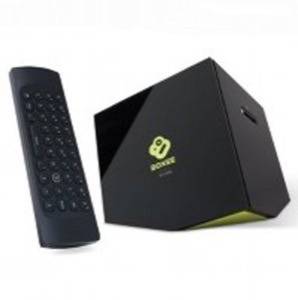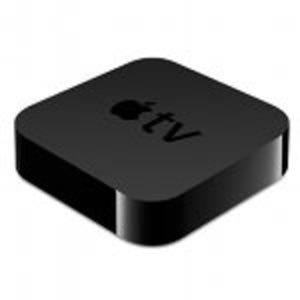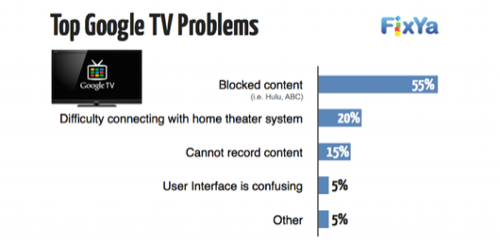The Internet is awesome. Whether for its uncanny knack for revolutionizing aspects of our day-to-day lives and upending industries to way it has redefined how and when we get amused, you’ve got to love this globe-spanning network of information we increasingly call home.

One area many expected the Web to have more dramatically revolutionized by now is television. And, to be sure, the way we consume and talk about TV content is quite different now than it was a decade ago, and that’s worth noting. But anybody who expected the Internet to dislodge legacy business models in TV as quickly as it did in say, the print media industry, still has some thumb-twiddling left to do.
A few years ago, the thought of there being a product in existence called “Google TV” would have sparked visions of some kind of game-changing, futuristic platform that rendered the cable subscriptions and broadcast signals we all grew up with a relic of the past. In reality, Google’s Web TV platform landed with something of a thud and has yet to be resuscitated.
Like the Roku, Apple TV and Boxee Box, Google TV has failed to catch on with mainstream TV-watching consumers, most of whom are still clinging to cable, even if some of them are having second thoughts. In theory, these boxes are great. When you plug in services like Netflix and Hulu Plus and combine that with the growing library of professional-quality video content from sources like YouTube and Vimeo, you can start to see why cable would become unnecessary for many consumers. But we’re not there yet.
From Roku to Apple TV, They All Have Problems
As it turns out, each of these platforms has its issues. Some are technical, while some have more to do with user experience and content accessibility. Whatever the case may be, it’s simply not possible for most consumers to sit down in front of a television connected to one of these boxes and have the seamless, lean back experience to which they’ve grown accustomed.
Despite the vow I made in a recent op-ed, I must confess that I recently bought the new Apple TV, primarily because I write about this space so much and I’m anxious to see where Apple takes the platform. The experience is better than I expected, but I still can’t fully get behind a Web TV box that has such limited content. On the other hand, using AirPlay mirroring to stream videos from one’s iPad is an incredibly valuable feature, and one that opens up the possibilities a little bit.

Still, the Apple TV has fewer features and content options than the Boxee Box, which I’ve owned for well over a year. Apple TV is great if you’re accustomed to purchasing and renting content from iTunes, but to truly harness the power of video content from across the Web, a more open platform like Boxee’s is probably the way to go.
Poor Content Selection is a Major Issue
A recent report from FixYa confirms that many consumers prefer Boxee’s feature set customizability to that of its its competitors. Evens so, it’s far from perfect. Just like Google TV, Boxee has been blocked from browsing to Hulu.com and the websites of several key content providers. For over a year, I was able to watch The Daily Show from Boxee’s main UI for free. One day, new episodes just disappeared without explanation. Boxee also doesn’t have access to Amazon’s video library, which the Roku stands alone in offering.

The lack of a thorough selection of content is one of the biggest gripes consumers have with these boxes. In the manufacturers’ defense, they’re dealing with nervous cable companies and content providers who are hesitant to upend very lucrative business models just so people can stream their favorite shows to their TV sets.
Take Hulu, for example. You can hook a laptop up to a TV set and watch whatever you want on Hulu.com. But when it comes to these set top boxes, Hulu only wants you to be able to access its paid subscription service, Hulu Plus. And even that has been very slow to arrive on Google TV or Boxee.
Hulu proper is blocked on platforms like Google TV and Boxee despite the fact that the site delivers ad impressions on a TV set just like it does to a desktop browser. So they’d still be monetizing that content if they let you stream it to your Boxee Box. To the content providers, the size of the screen makes a far bigger difference than it does to us.
Technical and UX Issues Make Web TV Less Appetizing
Many of the other issues mentioned in the FixYa report are strictly technical. The Roku sometimes has trouble connecting to the Internet, while Apple TV users have experienced issues logging into their iTunes accounts and getting AirPlay mirroring to work properly. On Boxee, the browser sometimes crashes and there are sometimes problems with audio playback.
Another issue is the user experience. Google TV got slammed for its poor UX when it first launched, although they’ve managed to make improvements.
I personally have never had a problem turning on and navigating my Boxee Box or Apple TV, but when my mother comes to visit, it’s another story. Sure, there’s a generational divide that often exists when it comes to using technology, but in my mother’s defense, she’s been accustomed to hitting the “on” button, sitting back and flipping through channels for the last 50 years.
Operating these new Web TV interfaces sometimes requires user training and patience, even if it’s only a little bit. It might not be an issue for the more savvy among us, but the fact that the user experience isn’t dead simple for everybody suggests there’s still some growing for the platforms to do.
Another issue frequently cited by consumers is the lack of DVR-style recording on these devices. For content that is streaming-only, this shouldn’t be a huge deal, assuming the videos remain online. The ability to record content from broadcast channels would be a big value add for many people. Even a central “watch it later” repository for Web content would come close to approximating the DVR functionality people want. To date, Boxee is the closest to achieving this, but it’s still not enough for most people. Rumor has it that Apple is working on some kind of DVR-style recording functionality for its mythical HDTV set. Until then, this will likely remain a sticking point for many would-be adopters of Web TV set top boxes.










